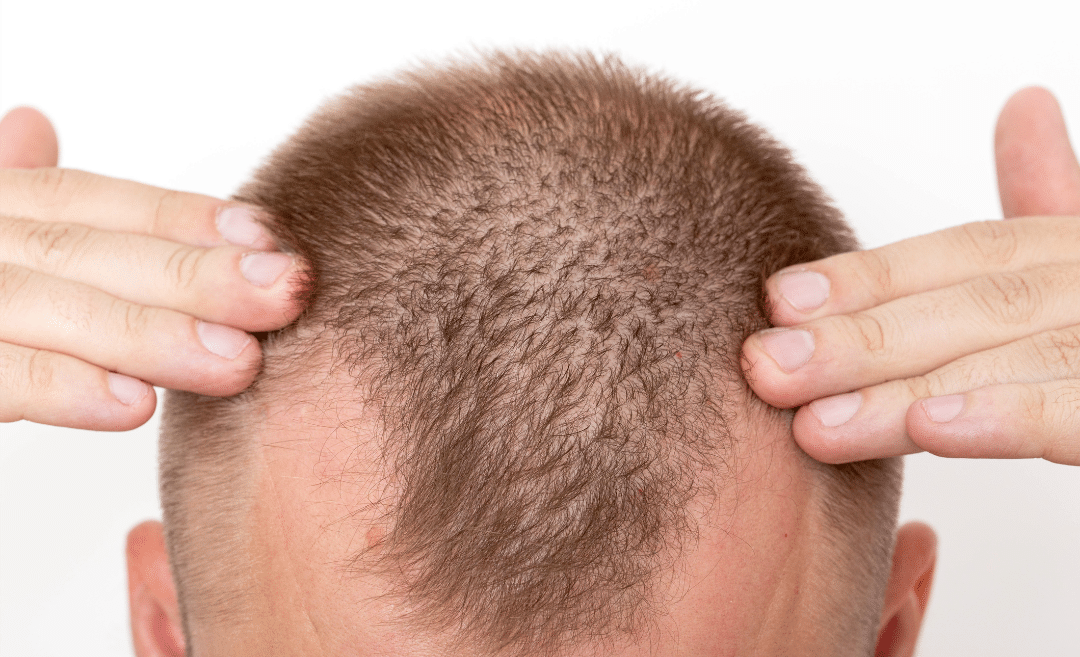Male pattern baldness is a widespread concern affecting men worldwide, leading to self-image anxiety and worries about aging. This blog post aims to comprehensively understand the causes, early signs, and typical age range for male pattern baldness. Additionally, we will explore the differences between female and male hair loss and discuss the available treatment options to empower you to control your hair health and seek personalized solutions.
When Does Male Pattern Baldness Start?
The onset of male pattern baldness is not uniform and can vary significantly among individuals. Men may sometimes start experiencing hair loss as early as their late teens or early twenties. However, for the majority, the initial signs of hair loss typically become noticeable between the ages of 30 and 50.
It is important to note that the progression of male pattern baldness also differs from person to person, with some individuals experiencing a slow decline in hair density. In contrast, others may lose hair more rapidly.
According to the American Hair Loss Association, by age 35, approximately two-thirds of American men will have experienced some noticeable hair loss. This number increases to around 85% by the age of 50. Furthermore, 25% of men affected by male pattern baldness begin to see the signs before they reach age 21. (1)
Causes of Male Pattern Baldness
A combination of genetics, hormones, and age influences male pattern baldness. Understanding these contributing elements can help you better manage hair loss and seek appropriate treatments. The primary factors are:
- Genetics: Your genetic makeup plays a significant role in determining your susceptibility to male pattern baldness. Family history of hair loss, inherited genes, and the sensitivity of hair follicles to hormonal changes all contribute.
- Hormones: Dihydrotestosterone (DHT) derived from testosterone binds to hair follicles, causing them to shrink over time. Hair follicles produce thinner, weaker hair strands, leading to hair loss. Some individuals have more sensitive follicles, accelerating hair loss. (2)
- Age: The risk of hair loss increases as men grow older. While it can start as early as the late teens or early twenties, it is more common between ages 30 and 50. Hair loss progression and rate can vary.
- Environmental Factors: Stress, poor nutrition, and certain medications can worsen hair loss. While not direct causes, they impact overall hair and scalp health, potentially speeding up hair loss.
Signs of Male Pattern Baldness
Male pattern baldness can manifest in several ways, and being aware of the early signs can help you seek timely treatment and potentially slow down hair loss. The key signs include the following:
- Receding Hairline
- Thinning Hair on the Crown
- Overall Decrease in Hair Density
- Change in Hair Texture
- Hair Loss on the Temples and Crown
Female vs. Male Hair Loss
When it comes to hair loss, there are notable differences between male and female patterns. Male pattern baldness typically follows a distinct pattern characterized by receding hairline and thinning at the crown. This pattern gradually progresses over time, leading to more extensive hair loss.
On the other hand, female hair loss tends to be more diffuse, with overall thinning across the entire scalp. Hormonal changes related to pregnancy, menopause, or birth control use can also contribute to female hair loss. (3)
Treatment Alternatives for Male Pattern Baldness
When it comes to addressing male pattern baldness, several treatment options are available, including medications, hair transplant procedures, and PRP therapy.
Medications:
Minoxidil (Rogaine) and Finasteride (Propecia) are commonly used medications for treating male hair loss.
- Minoxidil: This topical solution is directly applied to the scalp to stimulate hair follicles, promote hair growth, and slow down hair loss.
- Finasteride: An oral medication that reduces the production of dihydrotestosterone (DHT), a hormone linked to hair loss in genetically predisposed individuals.
Both medications have shown effectiveness in treating male pattern baldness, although they may require long-term use to maintain the results.
Hair Transplants:
Hair transplant procedures offer various techniques for individuals seeking a more permanent solution, including Follicular Unit Transplantation (FUT), Follicular Unit Extraction (FUE), and NeoGraft.
- FUT: This procedure involves removing a strip of hair-bearing scalp from the back of the head, dissecting it into individual hair grafts, and transplanting them to the balding areas.
- FUE: In this technique, hair follicles are directly extracted from the donor area using a specialized punch tool and then transplanted.
- NeoGraft: This automated FUE technique utilizes advanced technology to ensure precise and efficient hair transplantation.
These hair transplant procedures enable the transplantation of healthy hair follicles from the donor area to those experiencing hair loss, resulting in natural-looking hair growth and improved hair density.
PRP Therapy:
Another emerging treatment option for male pattern baldness is Platelet-Rich Plasma (PRP) therapy. This procedure involves drawing a small amount of blood from the patient, separating and concentrating the platelet-rich plasma, and injecting it into the scalp. PRP therapy utilizes growth factors in the platelet-rich plasma to stimulate hair growth and improve hair density.
Choosing the most suitable treatment option for male pattern baldness depends on individual factors, such as the extent of hair loss and personal preferences. Consulting with a qualified professional specializing in hair restoration will help determine the best treatment approach for your specific situation and goals.
Prevention and Lifestyle Changes for Healthier Hair
While it is impossible to completely prevent male pattern baldness, certain lifestyle changes can promote healthier hair and potentially slow down hair loss. Consider implementing the following practices:
- Balanced Diet
- Stress Management
- Avoiding Harsh Hair Treatments
- Regular Exercise
- Quitting Smoking
Conclusion
Understanding when male pattern baldness starts and recognizing the early signs of hair loss are crucial for taking control of your hair health. If you’re concerned about female or male hair loss, don’t hesitate to take action. Contact Anagen Hair Restoration at (301) 591-6552 or visit their website at https://anagenhairrestoration.com/ to schedule your consultation and explore personalized hair loss treatment options tailored to your unique needs.
Their experienced team is dedicated to helping you regain confidence and achieve the best possible results. Take the first step towards a revitalized appearance and renewed self-assurance today.


